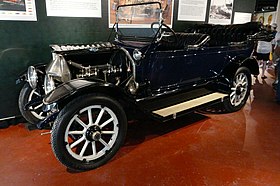Chevrolet Series C Classic Six
| Chevrolet Series C Classic Six | |
|---|---|
 |
|
| Overview | |
| Manufacturer | Chevrolet |
| Assembly | Flint Assembly, Flint, Michigan |
| Designer | Etienne Planche |
| Body and chassis | |
| Class | Full-size |
| Body style | 4-door touring |
| Layout | FR layout |
| Related | The Little Automobile |
| Powertrain | |
| Engine | 299 in3 40 hp, T head I6 |
| Transmission | rear-mounted 3-speed, with a cone clutch |
| Dimensions | |
| Wheelbase | 120.0 in (3,048 mm) |
| Curb weight | 3,500-3,750 lbs. |
| Chronology | |
| Successor | Series H and Series L |
The Chevrolet Series C Classic Six is a Brass Era American automobile, and is the first ever Chevrolet. It is one of the few Chevrolets made while record-setting Buick race car driver Louis Chevrolet was with the company. This early Chevy was much larger, more powerful, more stylized and therefore more expensive than the cars that would ultimately replace it. Louis Chevrolet loved it, but William Durant had a cheaper car in mind.
The 1913-14 Chevrolet Type C also called the Chevrolet Classic Six (Series C), Chevrolet Model C, Classic Six or, at the time it was new, simply the Chevrolet (since there were no other models to confuse it with until 1914 when the Model H and L were released), was the first Chevrolet, and was also sold by other makes. It was a well constructed car and had a 6-cylinder engine up front with a cone clutch and a three-speed gearbox mounted at the rear axle. Henry Ford had been selling his much less expensive Model T for three years, in six models by the time Chevrolet entered the market. The Chevrolets that followed, under the management of Durant, would be much cheaper 4-cylinder cars that competed directly with the T. The Series C Classic Six, however, was capable of 65 mph and competed against the more high-performance cars of that time. Standard equipment included a starter, four doors, a folding top, a tool box, cowl lights, and electric headlights. The 1914 Classic Six was in essence the 1913 model with a few slight changes.
Penned by Etienne Planche under direction from Louis Chevrolet, the Chevy with its low running boards had a design more resembling European cars. Radiator shell and Chevrolet nameplate on the dashboard (the "bow-tie" emblem did not appear until the 1914 Chevrolet Series H and L models) were polished metal, the body, chassis and wheels were only Chevrolet blue. The hood, fenders, and splash aprons were black. Light gray striping was found on the body and wheels. The first prototype car appeared in late 1911, and Louis Chevrolet himself tested it on the back streets of Detroit. Throughout 1912 refinements were made to the design. Later in that same year the new 1913 model was released at the New York Auto Show.
Chevrolet's first engine was a liquid-cooled 299-cubic-inch, six-cylinder cast-iron block cast in three groups of two, with a T-head configuration, that produced 40 horsepower. The T-head engine is a side valve engine that is distinguished from the much more common L-head engine by its placement of the valves. The intake valves are on one side of the engine block and the exhaust valves on the other, making dual camshafts necessary. Seen from the end of the crankshaft, in cutaway view, the cylinder and combustion chamber resembles a T - hence the name "T-head". The 299 was a very large engine at that time and the only engine in the C Series. In 1913 the ignition was a Simms magneto with a compressed-air starter. For 1914 the ignition was now a Simms High Tension Magneto and the starter used was a Gray & Davis. This was the biggest Chevy engine until the 1958, 348 cid V-8.?
...
Wikipedia
